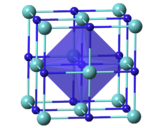碳化钽
| 碳化钽 | |
|---|---|

| |

| |
| IUPAC名 Tantalum carbide | |
| 别名 | 碳化钽(IV) |
| 识别 | |
| CAS号 | 12070-06-3 12070-07-4((TaC0.5)) |
| SMILES |
|
| InChI |
|
| InChIKey | DUMHRFXBHXIRTD-UHFFFAOYSA-N |
| 性质 | |
| 化学式 | TaC |
| 摩尔质量 | 192.96 g/mol g·mol⁻¹ |
| 外观 | 棕灰色粉末 |
| 氣味 | 无臭 |
| 密度 | 14.3–14.65 g/cm3 (TaC) 15.1 g/cm3 (TaC0.5)[1] |
| 熔点 | 3,850—3,880 °C(4,120—4,150 K)(TaC)[2] 3,327 °C(6,021 °F;3,600 K) (TaC0.5)[1] |
| 沸点 | 4,780—5,470 °C(5,050—5,740 K)(TaC)[1][2] |
| 溶解性(水) | 不溶 |
| 溶解性 | 可溶于HF-HNO3的混合物[1] |
| 熱導率 | 21 W/m·K |
| 热力学 | |
| ΔfHm⦵298K | −144.1 kJ/mol |
| S⦵298K | 42.29 J/mol·K |
| 热容 | 36.71 J/mol·K[3] |
| 相关物质 | |
| 相关化学品 | 一氮化锆 碳化铌 碳化锆 |
| 若非注明,所有数据均出自标准状态(25 ℃,100 kPa)下。 | |
碳化钽是一类二元化合物,由钽和碳组成,实验式TaCx,x 一般在 0.4 到1 之间。它们的硬度极大,脆,是耐火材料,具有金属的电导率。它是一种棕灰色粉末,通常通过烧结处理。
作为重要的金属陶瓷材料,碳化钽在商业车刀中用于切削应用,有时会添加到碳化钨合金中。[4]
取决于纯度和测量条件,碳化钽的熔点在约3880℃达到峰值。这个值是二元化合物里最高的。[5][6]只有碳化钽铪的熔点可能略高,大约为3942°C,[7]而碳化铪的熔点与TaC相当。
制备
[编辑]TaCx粉末是由钽和石墨的粉末在真空或惰性气体(氩)里使用炉子或电弧熔化装置在约2000℃的温度下进行加热。[8][9]钽和石墨的量决定了x的值。另一种技术是在真空或氢气气氛中,在1500–1700℃的温度下通过碳进行五氧化二钽的还原。该方法于1876年用于获得碳化钽,[10]但它无法控制产物的化学计量。[6]自蔓延高温合成法也是已报道的直接从单质制备TaC的方法之一。[11]
晶体结构
[编辑]
当 x = 0.7–1.0 时,TaCx有着立方结构 (岩盐的结构) 。[12]碳化钽的晶格常数会随着x增长而增长。[13] TaC0.5有两种结构。较稳定的具有反碘化镉型三角结构,该结构在加热至约2000℃时转变为六方晶格,对碳原子来说已经没有规律了。[8]
| 实验式 | 对称性 | 种类 | 皮尔逊符号 | 空间群 | No | Z | ρ (g/cm3) | a (nm) | c (nm) |
|---|---|---|---|---|---|---|---|---|---|
| TaC | 立方 | NaCl[13] | cF8 | Fm3m | 225 | 4 | 14.6 | 0.4427 | |
| TaC0.75 | 三方[14] | hR24 | R3m | 166 | 12 | 15.01 | 0.3116 | 3 | |
| TaC0.5 | 三方[15] | 反-CdI2 | hP3 | P3m1 | 164 | 1 | 15.08 | 0.3103 | 0.4938 |
| TaC0.5 | 六方[9] | hP4 | P63/mmc | 194 | 2 | 15.03 | 0.3105 | 0.4935 |
在这个表中,Z是每单位的配位数,ρ是由晶格常数计算而来的密度。
性质
[编辑]碳化钽中钽和碳原子之间的键是离子键,金属键和共价键混合,是很复杂的键,并且由于强共价成分,这些碳化物是非常坚硬且易碎的材料。举个例子,TaC的显微硬度为1600-2000 kg/mm2 [16](〜9 Mohs)和285 GPa的弹性模量,而钽的相应值为110 kg/mm2和186 GPa。碳化钽的硬度,屈服和剪切应力随TaCx中碳含量的增加而增加。[17]
碳化钽无论是什么大小和温度都具有金属导电性。TaC 可以在10.35 K以下转变为超导体。[13]
TaCx的磁性能从x≤0.9的反磁性变为“ x”≥0.9的顺磁性。尽管HfCx具有与TaCx相同的晶体结构,但仍观察到了相反的行为(磁性随x的增加而减少)。[18]
应用
[编辑]碳化钽因其在熔点、硬度、弹性模量、导热性、热冲击方面的优异物理性能而被广泛用作超高温陶瓷(UHTC)的烧结添加剂或高熵合金(HEA)的陶瓷增强材料抵抗力和化学稳定性,这使其成为航空航天工业中飞机和火箭的理想材料。
天然存在
[编辑]鉭碳礦是碳化钽的天然存在形式。它属立方晶系,并且非常稀有。[19]
参见
[编辑]参考资料
[编辑]- ^ 1.0 1.1 1.2 1.3 Lide, David R. (编). CRC Handbook of Chemistry and Physics 90th. Boca Raton, Florida: CRC Press. 2009. ISBN 978-1-4200-9084-0 (英语).
- ^ 2.0 2.1 5196273[失效連結]
- ^ Tantalum carbide in Linstrom, Peter J.; Mallard, William G. (eds.); NIST Chemistry WebBook, NIST Standard Reference Database Number 69, National Institute of Standards and Technology, Gaithersburg (MD), http://webbook.nist.gov (retrieved 2014-07-02)
- ^ Emsley, John. Nature's building blocks: an A-Z guide to the elements. Oxford University Press. 11 August 2003: 421– [2 May 2011]. ISBN 978-0-19-850340-8.
- ^ TaC0.89中4000°C的熔点声称不是基于实际测量,而是基于相图的推断,使用与NbC的类比,请参见Emeléus
- ^ 6.0 6.1 Emeléus, Harry. Advances in Inorganic Chemistry and Radiochemistry. Academic Press. 1968: 174–176 [3 May 2011]. ISBN 978-0-12-023611-4. (原始内容存档于2017-03-24).
- ^ Agte, C.; Alterthum, H. Researches on Systems with Carbides at High Melting Point and Contributions to the Problem of Carbon Fusion. Zeitschrift für technische Physik. 1930, 11: 182–191. ISSN 0373-0093.
- ^ 8.0 8.1 Lonnberg, B; Lundstrom, T; Tellgren, R. A neutron powder diffraction study of Ta2C and W2C. Journal of the Less Common Metals. 1986, 120 (2): 239–245. doi:10.1016/0022-5088(86)90648-X.
- ^ 9.0 9.1 Rudy, Erwin; Brukl, C. E.; Windisch, Stephan. Constitution of Ternary Ta-Mo-C Alloys. Journal of the American Ceramic Society. 1968, 51 (5): 239–250. doi:10.1111/j.1151-2916.1968.tb13850.x.
- ^ Joly, A. Sur les azotures et carbures de niobium et de tantale. Compt. Rend. 1876, 82: 1195 [2020-07-14]. (原始内容存档于2020-07-16) (法语).
- ^ Shuck, Christopher E.; Manukyan, Khachatur V.; Rouvimov, Sergei; Rogachev, Alexander S.; Mukasyan, Alexander S. Solid-flame: Experimental validation. Combustion and Flame. January 2016, 163: 487–493. doi:10.1016/j.combustflame.2015.10.025.
- ^ Lavrentyev, A; Gabrelian, B; Vorzhev, V; Nikiforov, I; Khyzhun, O; Rehr, J. Electronic structure of cubic HfxTa1–xCy carbides from X-ray spectroscopy studies and cluster self-consistent calculations. Journal of Alloys and Compounds. 2008, 462 (1–2): 4–10. doi:10.1016/j.jallcom.2007.08.018.
- ^ 13.0 13.1 13.2 Valvoda, V. X-ray diffraction study of Debye temperature and charge distribution in tantalum monocarbide. Physica Status Solidi A. 1981, 64: 133–142. doi:10.1002/pssa.2210640114.
- ^ Yvon, K.; Parthé, E. On the crystal chemistry of the close-packed transition-metal carbides. I. The crystal structure of the [zeta]-V, Nb and Ta carbides. Acta Crystallographica Section B. 1970, 26 (2): 149–153. doi:10.1107/S0567740870002091.
- ^ Bowman, A. L.; Wallace, T. C.; Yarnell, J. L.; Wenzel, R. G.; Storms, E. K. The crystal structures of V2C and Ta2C. Acta Crystallographica. 1965, 19: 6–9. doi:10.1107/S0365110X65002670.
- ^ Kurt H. Stern (1996). Metallurgical and Ceramic Protective Coatings. Chapman & Hall.
- ^ Oyama, S. Ted. The chemistry of transition metal carbides and nitrides. Springer. 1996: 29–30 [3 May 2011]. ISBN 978-0-7514-0365-7. (原始内容存档于2020-07-14).
- ^ Gusev, Aleksandr; Rempel, Andrey; Magerl, Andreas. Disorder and order in strongly nonstoichiometric compounds: transition metal carbides, nitrides, and oxides. Springer. 2001: 513–516 [3 May 2011]. ISBN 978-3-540-41817-7. (原始内容存档于2020-08-11).
- ^ Mindat, Tantalcarbide (页面存档备份,存于互联网档案馆). [2020-07-27]
